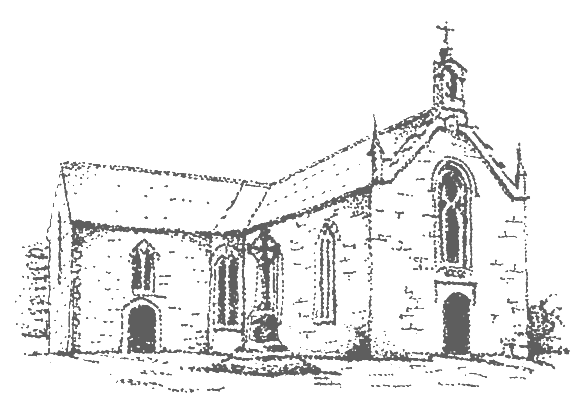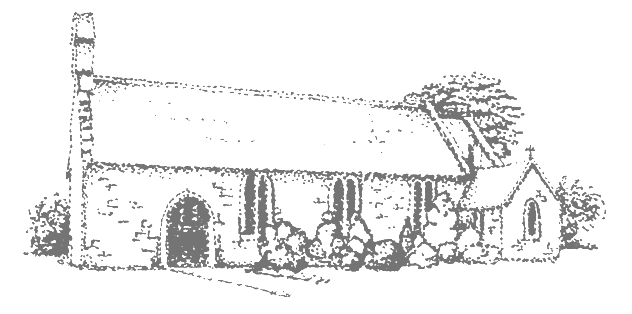ST. MARY’S CATHOLIC CHURCH ASKEATON
The present Catholic Church is part of a long line of churches in Askeaton, going back at least to the church of the Knights Templar in Church St. and to the church that was part of the Geraldine castle building. The present, cruciform, church dates from 1851. Immediately before that, the church was located beside the Franciscan Abbey, to the right of the main Abbey Gate, until it was destroyed by fire in 1847.
The present church has been renovated on several occasions since 1851, the most notable being in 1977. In 2008 the sanctuary received a new reredos. The church has had many other features and repairs added over the years.
Outside Plaque
On the outside, over the front door of the church, is a plaque in commemoration of the dedication of the church. It reads:
Haec Ecclesia Deo Dedicata Est In Honorem
Beatae Mariae Virginis, A.D. 1851.
Ave Maria, gratia plena Dominus tecum, benedicta
Tu in mulieribus et benedictus fructis ventris tui Jesus
Revdo E. Cussen, Pastor
(Translation: This church has been dedicated to God in honour of the Blessed Virgin Mary, A.D. 1851. Hail Mary, full of grace, the Lord is with thee, blessed art thou among women and blessed is the fruit of thy womb, Jesus. Very Rev. E. Cussen, Parish Priest.)
The Pieta
Over the main door, on the inside, there is a large Pieta. This is a depiction of the dead Christ in the arms of Mary.
Statue of Our Lady
The statue seeks to represent Mary as she appeared in Lourdes to St. Bernadette in 1858. When asked her name, Mary replied, ‘I am the Immaculate Conception’.
The Ionad Guí (Prayer Space)
The Ionad Guí (Prayer Space) is situated in the east transept of the church. Its inspiration comes from our ancient heritage in Celtic spirituality. The Water Feature is intended to represent the traditional Holy Well. The Icons, Christian art in the Eastern Christian tradition, cover the central themes in iconography, namely, Jesus, the Blessed Trinity and Mary the Mother of God.
Wooden Cross
Often in the sanctuary a wooden Cross, carved with the Stations of the Cross, can be seen. This was purchased in Bethlehem from a local family of craftsmen during the parish pilgrimage to the Holy Land in 2011.
Stained Glass Windows
There are five stained glass windows in the church. The four large ones, installed in the 1920’s were fashioned by F. Mayer of Munich and London. The window of Our Lady was installed in the early 1950’s.
(Franz Mayer & Co. is a German stained glass design and manufacturing company, based in Munich, Germany, that has been active throughout most of the world for over 150 years. The firm was very popular during the late nineteenth and early twentieth century. Franz Mayer and Co. were stained glass artists to the Holy See and consequently were popular with Catholic churches and the principal provider of stained glass to the large Catholic churches that were constructed throughout the world during that period. Stylistically, Mayer's windows tend to contain richly coloured scenes bordered by architectural frames. They were valued for their aesthetic quality as well as for their ability to engage the viewer emotionally and spiritually. The studio often incorporated imagery from Great Master paintings (e.g. Masaccio, Raphael and Michelangelo) as well as compositions of the nineteenth century. The Mayer Co. is responsible for stained glass in at least 10 of Ireland's Cathedrals and in over 50 other churches, including Askeaton. )
Left of the main aisle: St. Patrick receiving Ethne and Fedelm (daughters of High King Laoghaire) into the church.
Right of the main aisle: Jesus surrounded by little children.
In the east transept: The Resurrection of Christ.
In the west transept: Christ's Ascension into Heaven
Over the main door: Our Lady
Limestone Monument
This was erected in the church grounds in 2001, on the east side, to mark the sesquicentennial anniversary of the building of the church. This is a limestone monument containing a Celtic triad design which represents the old Celtic belief that the most important things in life come in threes. This prepared our ancestors for the Christian Mystery of the Blessed Trinity.
Millennium Tree
Close to the Limestone Monument, this oak tree was planted on New Year’s Eve, 1999/2000, to symbolize our hopes and aspirations for peace in the third millennium.
Graves
To the east of the church there are several graves of priests who served formerly in the parish. The Celtic Cross, on the west side of the church grounds, was erected to mark the grave of Fr. Edmund Treacy, P.P. (1892-1908).
Spiritual Garden of Remembrance
The Garden is at the rear of the church in Askeaton.
(See the separate leaflet with detailed information).
Photographs
To see some photos of the church go to, 'Gallery'.

